
What Are Isometrics
Isometric exercises are when your muscles tense / contract with no actual movement from your body. An example would be when a person performs the plank exercise or when you flex your bicep; you are not achieving any real action, but the squeezing will create an active contraction within your muscle.
When you perform your isometrics, the goal is a maximal voluntary contraction. This just means you need to create the greatest amount of tension that your muscle can generate and hold, however briefly. This article will cover different isometric exercises for your core specifically focusing on the abdominals.
To receive the best possible results from isometrics you need to be performing them at a different time than your main workout. Progression should also be a primary focus in your isometric training if you are first starting use five sets with a ten-second squeeze and work on increasing the number of sets and the duration you are performing the squeeze.
What makes isometrics so useful is that maximum voluntary contraction is shown to recruit the largest motor units and the neural drive from your brain's motor cortex and the muscles involved in the contraction. This is very different from lifting a weight since when you are lifting the tension in the muscle will fluctuate as you move the weight making it harder to feel the entire muscle working.
Tip Control Your Breathing
Many people seem to have a natural tendency not to breath when performing isometrics. Tightening your muscles leads many people to stop their breathing. Try to Inhale for two- three seconds and exhale for two- three seconds. This is the type of breathing you should focus on doing during your isometric exercises.
Isometric ab Exercises List
The Plank

The plank is a great full body exercise with a primary focus on your core. It has also been shown to help improve a person's flexibility by stretching muscles and has also proved to improve posture when performed on a consistent basis.
Tips & Safety
If you find that the plank places to much strain on your elbows you can try to perform it with your arms extended, to protect your wrists in this position remember to leave a small hollow in your hands.
- Begin by laying face down in the press position.
- Bend your elbows by 90 degrees with your forearms (not your hands) flat on the ground (your forearms are used to support your weight).
- Align your body into a straight line from your shoulders to your ankles.
- Flex your core (like you are trying to show your abdominals) while sucking your belly button inwards toward your spine
- Hold this position for the prescribed amount of time.
Side Plank
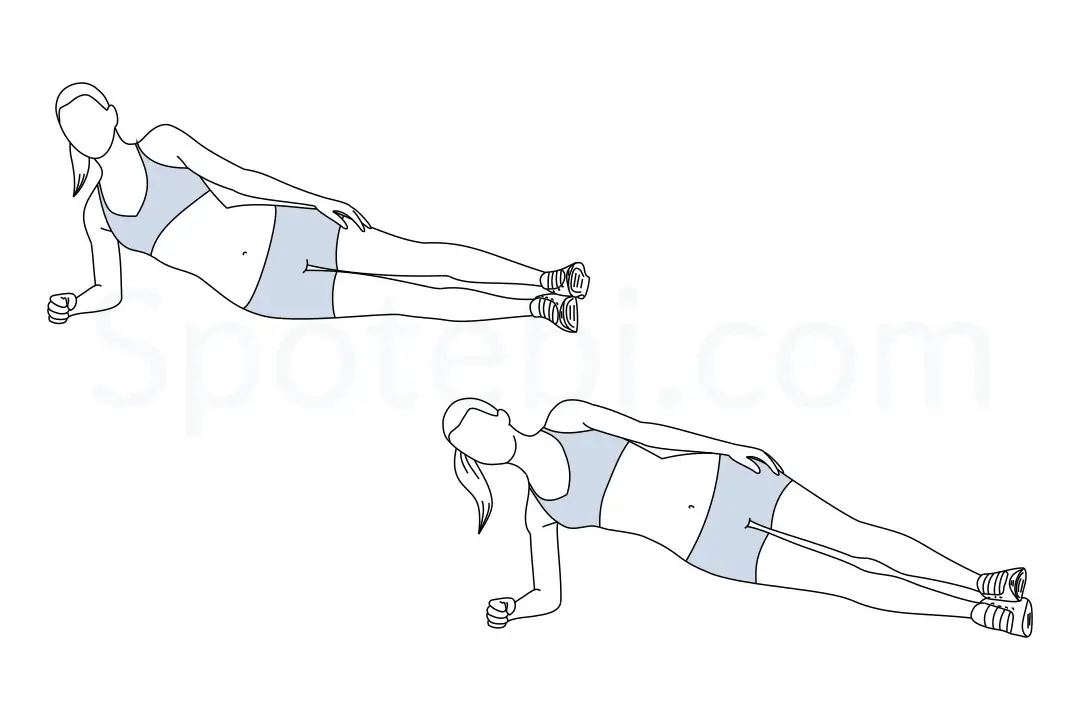
- Begin by turning onto your right side with your legs extended with one leg stacked on top of the other.
- Your right elbow should be placed directly under your shoulder holding up your torso, be sure to keep your head in line with your spine.
- Now contract your core while lifting your hips and knees off of the floor.
- Hold this position for the prescribed amount of time.
- Lower back to the starting position. Repeat for the desired number of repetitions.
- Switch to the other side and repeat.
Side Plank Leg Raise

- Begin with your left elbow on the ground directly under your shoulder.
- Extend your legs so that your body is in a straight line with your legs stacked on one another.
- Now balance on the outside edge of your left foot while reaching with your right hand toward the ceiling.
- Engage your abdominals well keeping your head in line with your spine and lift your hips and knees off of the floor.
- Lift your right leg up so that it is just over the top of your hip hold and then in a slow controlled movement lower your leg until it is stacked on your left leg again.
- Make sure to keep your waist lifted and do not allow your bottom shoulder to sink.
- Switch to the other side and repeat.
Weighted Holds and Carries
Weighted holds and carries are a very useful isometric abdominal exercises. To work your core to a greater degree, you should hold the weight with only a single hand. We will show two separate carry activities that will require your abdominals to work isometrically for your torso to stay vertical. If you have limited space, you can perform these exercises on the spot instead of moving. The two holds to help strengthen your core are the Farmers Walk (weight is held down at your side) and the Waiter's Walk (when the weight is above your head).
Farmers Walk

Waiters Walk
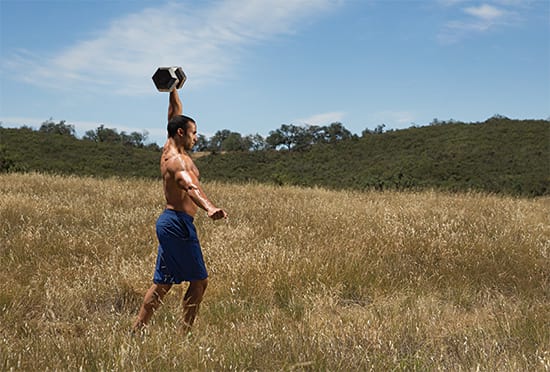
Flutter Kicks
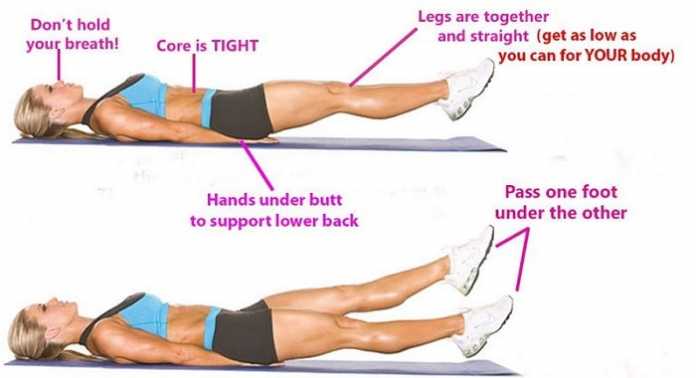
The goal of flutter kicks is to hold your abdominals in an intense isometric contraction to ensure your lower back is kept firmly pressed firmly against the floor. If you find that you are not able to keep your back pressed into the floor during this exercise, it is because your abdominals are not yet powerful enough to perform this movement. To help prevent injury you should continue to strengthen your abdominals with planks for a couple of weeks and try this exercise again.
- Start by laying on your back with your legs extended out.
- Press your lower back into the floor while you contract your abdominals.
- Slightly lift your feet off of the floor by about six inches (continue to maintain tension in your abdominals).
- Now lift your left leg first another six to eight inches.
- Then start to lift your right leg six to eight inches while at the same time lower your left foot back to the original position six inches off of the floor.
- Now switch start lowering your right leg and raising your left foot.
- Continue this movement for the number of repetitions or specific time duration.
Isometric stomach flattener
- Sit in a chair tall and straight.
- Begin by breathing deep and suck in your stomach as hard as you are able.
- Flex you stomach hard well still keeping it sucked in.
- Hold for five seconds.
- Now breath out and make an "SSSSSSSSS" sound while you continue to have your stomach flexed. As you are doing this, you should feel that your abs are getting tighter.
- As you are breathing out crunch your abdominals while rotating your pelvis upwards and your rib cage inwards.
- Continue until you have blown out all of your breath.
- You have now completed your first rep.
Pelvic Tilt
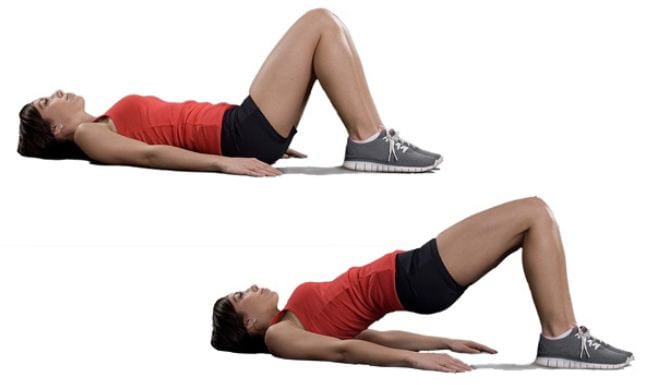
The pelvic tilt is a great beginner exercise to help strengthen your abdominal muscles.
- Begin by lying on your back with your knees bent.
- Tighten your stomach muscles and make sure your back stays pressed against the floor.
- Bend your pelvis up slightly and hold for ten seconds.
Glute Bridge Hold
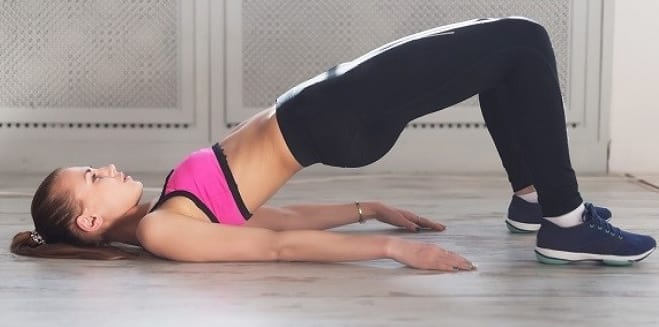
You can alter the focus of this exercise by switching your foot position. By having your feet closer to your butt, you will engage your glutes to a higher degree. By moving your feet further away from your butt, you will help to focus more on your hamstrings. To perform a more advanced version you can use the single leg variation, or you can place your feet on a power wheel.
- Begin by laying on your back have your feet flat on the ground with your knees bent.
- Pull your heels in so that they are inline with your knees (you should be able to graze your heels with your fingertips when you stretch your arms down by your side).
- Have your knees and feet hip-width apart.
- Bend your elbows to 90 degrees (only your upper arms should still be touching the ground).
- Drive from your heels, upper back and arms to lift your hips up.
- Make sure that you fully extend your hips and to squeeze your glutes as you lift your hips up.
- Hold at the top with your abs engaged and glutes squeezed.
- Focus on engaging and contracting your muscles.
Banana
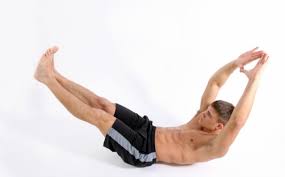
The banana is an advanced variation of the pelvic tilt. If you have never performed the pelvic tilt, I strongly advise spending at least a couple of weeks performing the exercises. Focus on keeping your abdominals engaged and once you are comfortable performing the pelvic tilt move on to the banana activity.
- Begin by lying on your back and have your legs out straight with your arms reaching overhead on the ground.
- Your arms should be right beside your head, and you need to have your legs together.
- Begin to lift your arms and legs up off of the ground while you press your lower back into the floor and flex your abdominals bringing them in towards your spine.
- Keep your neck and head in a neutral position between your arms and legs. Make sure that your feet stay together and are out straight a few inches above the ground.
- Hold in this position and squeeze your legs together while you lift your shoulder blades off of the ground be sure to keep your back against the ground and your abdominals engaged.
Start Isometric Ab Exercises Today
While this list does not cover every isometric abdominal exercise that there is, it is more than enough for you to start taking your core strength to the next level. If you are unable to correctly complete any of the exercises listed above take a break from that exercise and spend a couple of weeks on some of the ones you can do and then try again.
Continue attempting each exercise and taking a couple of weeks off from the actions you find too difficult and in no time you will master all 10 of the training activities we have shown.
Remember the goal is to complete the exercises with proper form so take your time and learn the movement pattern, well moving at a pace you are comfortable with doing. This will help you lower your chances of getting injured and allow you to continue making progress.
If there is an Isometric Ab Exercises you like or are just curious about that we did or did not cover, leave us a comment to let us know, and we will include it in a future post.
Looking to gain more strength or lose some weight? We offer free fitness tools to help you reach your fitness goals. Register for free while we are in beta and get free lifetime access to our fitness tools that include an easy to use Calorie Counter, High-Intensity Interval Timer, Multiple Fitness Calculators and our Exercise Logger.